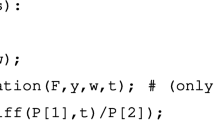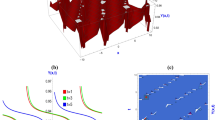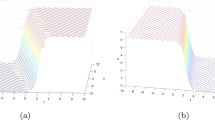Abstract
General rogue waves are derived for the generalized derivative nonlinear Schrödinger (GDNLS) equations by a bilinear Kadomtsev–Petviashvili (KP) reduction method. These GDNLS equations contain the Kaup–Newell equation, the Chen–Lee–Liu equation and the Gerdjikov–Ivanov equation as special cases. In this bilinear framework, it is shown that rogue waves to all members of these equations are expressed by the same bilinear solution. Compared to previous bilinear KP reduction methods for rogue waves in other integrable equations, an important improvement in our current KP reduction procedure is a new parameterization of internal parameters in rogue waves. Under this new parameterization, the rogue wave expressions through elementary Schur polynomials are much simpler. In addition, the rogue wave with the highest peak amplitude at each order can be obtained by setting all those internal parameters to zero, and this maximum peak amplitude at order N turns out to be \(2N+1\) times the background amplitude, independent of the individual GDNLS equation and the background wavenumber. It is also reported that these GDNLS equations can be decomposed into two different bilinear systems which require different KP reductions, but the resulting rogue waves remain the same. Dynamics of rogue waves in the GDNLS equations is also analyzed. It is shown that the wavenumber of the constant background strongly affects the orientation and duration of the rogue wave. In addition, some new rogue patterns are presented.



Similar content being viewed by others
References
Agrawal, G.P.: Nonlinear Fiber Optics, 3rd edn. Academic Press, San Diego (2001)
Akhmediev, N., Ankiewicz, A., Taki, M.: Waves that appear from nowhere and disappear without a trace. Phys. Lett. A 373, 675–678 (2009a)
Akhmediev, N., Ankiewicz, A., Soto-Crespo, J.M.: Rogue waves and rational solutions of the nonlinear Schrödinger equation. Phys. Rev. E 80, 026601 (2009b)
Ankiewicz, A., Clarkson, P.A., Akhmediev, N.: Rogue waves, rational solutions, the patterns of their zeros and integral relations. J. Phys. A 43, 122002 (2010a)
Ankiewicz, A., Akhmediev, N., Soto-Crespo, J.M.: Discrete rogue waves of the Ablowitz-Ladik and Hirota equations. Phys. Rev. E 82, 026602 (2010b)
Ankiewicz, A., Soto-Crespo, J.M., Akhmediev, N.: Rogue waves and rational solutions of the Hirota equation. Phys. Rev. E 81, 046602 (2010c)
Ankiewicz, A., Bokaeeyan, M., Akhmediev, N.: Rogue waves under influence of Raman delay. J. Opt. Soc. Am. B 35, 899–908 (2018)
Baronio, F., Degasperis, A., Conforti, M., Wabnitz, S.: Solutions of the vector nonlinear Schrödinger equations: evidence for deterministic rogue waves. Phys. Rev. Lett. 109, 044102 (2012)
Baronio, F., Conforti, M., Degasperis, A., Lombardo, S., Onorato, M., Wabnitz, S.: Vector rogue waves and baseband modulation instability in the defocusing regime. Phys. Rev. Lett. 113, 034101 (2014)
Baronio, F., Frisquet, B., Chen, S., Millot, G., Wabnitz, S., Kibler, B.: Observation of a group of dark rogue waves in a telecommunication optical fiber. Phys. Rev. A 97, 013852 (2018)
Chabchoub, A., Hoffmann, N.P., Akhmediev, N.: Rogue wave observation in a water wave tank. Phys. Rev. Lett. 106, 204502 (2011)
Chabchoub, A., Hoffmann, N., Onorato, M., Slunyaev, A., Sergeeva, A., Pelinovsky, E., Akhmediev, N.: Observation of a hierarchy of up to fifth-order rogue waves in a water tank. Phys. Rev. E 86, 056601 (2012)
Chan, H.N., Chow, K.W., Kedziora, D.J., Grimshaw, R.H.J., Ding, E.: Rogue wave modes for a derivative nonlinear Schrödinger model. Phys. Rev. E 89, 032914 (2014)
Chen, H.H., Lee, Y.C., Liu, C.S.: Integrability of nonlinear Hamiltonian systems by inverse scattering method. Phys. Scr. 20, 490 (1979)
Chen, J., Chen, Y., Feng, B.F., Maruno, K.I., Ohta, Y.: General high-order rogue waves of the (1 + 1)-dimensional Yajima-Oikawa system. J. Phys. Soc. Jpn. 87, 094007 (2018a)
Chen, J., Feng, B.F., Maruno, K., Ohta, Y.: The derivative Yajima-Oikawa system: bright, dark soliton and breather solutions. Stud. Appl. Math. 141, 145–185 (2018b)
Chen, S., Zhou, Y., Bu, L., Baronio, F., Soto-Crespo, J.M., Mihalache, D.: Super chirped rogue waves in optical fibers. Opt. Exp. 27, 11370–11384 (2019)
Chow, K.W., Chan, H.N., Kedziora, D.J., Grimshaw, R.H.J.: Rogue wave modes for the long wave-short wave resonance model. J. Phys. Soc. Jpn. 82, 074001 (2013)
Clarkson, P.A., Cosgrove, C.M.: Painlevé analysis of the nonlinear Schrödinger family of equations. J. Phys. A 20, 2003–2024 (1987)
Clarkson, P.A., Dowie, E.: Rational solutions of the Boussinesq equation and applications to rogue waves. Trans. Math. Appl. 1, 1–26 (2017)
Dubard, P., Matveev, V.B.: Multi-rogue waves solutions: from the NLS to the KP-I equation. Nonlinearity 26, R93–R125 (2013)
Dubard, P., Gaillard, P., Klein, C., Matveev, V.B.: On multi-rogue wave solutions of the NLS equation and positon solutions of the KdV equation. Eur. Phys. J. Spec. Top. 185, 247–258 (2010)
Dysthe, K., Krogstad, H.E., Müller, P.: Oceanic rogue waves. Annu. Rev. Fluid Mech. 40, 287–310 (2008)
Feng, B.F., Maruno, K.I., Ohta, Y.: Geometric formulation and multi-dark soliton solution to the defocusing complex short pulse equation. Stud. Appl. Math. 138, 343–367 (2017)
Frisquet, B., Kibler, B., Morin, P., Baronio, F., Conforti, M., Millot, G., Wabnitz, S.: Optical dark rogue wave. Sci. Rep. 6, 20785 (2016)
Gerdjikov, V.S., Ivanov, I.: A quadratic pencil of general type and nonlinear evolution equations. II. Hierarchies of Hamiltonian structures. Bulg. J. Phys. 10, 130–143 (1983)
Gilson, C., Hietarinta, J., Nimmo, J., Ohta, Y.: Sasa-Satsuma higher-order nonlinear Schrödinger equation and its bilinearization and multisoliton solutions. Phys. Rev. E 68, 016614 (2003)
Guo, B.L., Ling, L.M., Liu, Q.P.: Nonlinear Schrodinger equation: generalized Darboux transformation and rogue wave solutions. Phys. Rev. E 85, 026607 (2012)
Guo, B.L., Ling, L.M., Liu, Q.P.: High-order solutions and generalized Darboux transformations of derivative nonlinear Schrödinger equations. Stud. Appl. Math. 130, 317–344 (2013)
Guo, L.J., Zhang, Y.S., Xu, S.W., Wu, Z.W., He, J.S.: The higher order rogue wave solutions of the Gerdjikov-Ivanov equation. Phys. Scr. 89, 035501 (2014)
Kakei, S., Sasa, N., Satsuma, J.: Bilinearization of a generalized derivative nonlinear Schrödinger equation. J. Phys. Soc. Jpn. 64, 1519–1523 (1995)
Kaup, D.J., Newell, A.C.: An exact solution for a derivative nonlinear Schrödinger equation. J. Math. Phys. 19, 798–801 (1978)
Kedziora, D.J., Ankiewicz, A., Akhmediev, N.: Circular rogue wave clusters. Phys. Rev. E 84, 056611 (2011)
Kharif, C., Pelinovsky, E., Slunyaev, A.: Rogue Waves in the Ocean. Springer, Berlin (2009)
Kibler, B., Fatome, J., Finot, C., Millot, G., Dias, F., Genty, G., Akhmediev, N., Dudley, J.M.: The Peregrine soliton in nonlinear fibre optics. Nat. Phys. 6, 790–795 (2010)
Kivshar, Y.S., Agrawal, G.P.: Optical Solitons: From Fibers to Photonic Crystals. Academic Press, San Diego (2003)
Kundu, A.: Landau-Lifshitz and higher-order nonlinear systems gauge generated from nonlinear Schrödinger-type equations. J. Math. Phys. 25, 3433–3438 (1984)
Ling, L.M., Feng, B.F., Zhu, Z.: Multi-soliton, multi-breather and higher order rogue wave solutions to the complex short pulse equation. Physica D 327, 13–29 (2016)
Mio, K., Ogino, T., Minami, K., Takeda, S.: Modified nonlinear Schröinger equation for Alfvén waves propagating along the magnetic field in cold plasmas. J. Phys. Soc. Jpn. 41, 265 (1976)
Mjolhus, E.: On the modulational instability of hydromagnetic waves parallel to the magnetic field. J. Plasma Phys. 16, 321–334 (1976)
Moses, J., Malomed, B.A., Wise, F.W.: Self-steepening of ultrashort optical pulses without self-phasemodulation. Phys. Rev. A 76, 021802 (2007)
Mu, G., Qin, Z.: Dynamic patterns of high-order rogue waves for Sasa-Satsuma equation. Nonlinear Anal. Real World Appl. 31, 179–209 (2016)
Ohta, Y., Yang, J.: General high-order rogue waves and their dynamics in the nonlinear Schrödinger equation. Proc. R. Soc. Lond. A 468, 1716–1740 (2012a)
Ohta, Y., Yang, J.: Rogue waves in the Davey-Stewartson I equation. Phys. Rev. E 86, 036604 (2012b)
Ohta, Y., Yang, J.: Dynamics of rogue waves in the Davey-Stewartson II equation. J. Phys. A 46, 105202 (2013)
Ohta, Y., Yang, J.: General rogue waves in the focusing and defocusing Ablowitz-Ladik equations. J. Phys. A 47, 255201 (2014)
Peregrine, D.H.: Water waves, nonlinear Schrodinger equations and their solutions. J. Aust. Math. Soc. B 25, 16–43 (1983)
Qiu, D.Q., He, J.S., Zhang, Y.S., Porsezian, K.: The Darboux transformation of the Kundu–Eckhaus equation. Proc. R. Soc. A 471, 20150236 (2015)
Solli, D.R., Ropers, C., Koonath, P., Jalali, B.: Optical rogue waves. Nature 450, 1054–1057 (2007)
Wabnitz, S. (ed.): Nonlinear Guided Wave Optics: A Testbed for Extreme Waves. IOP Publishing, Bristol (2017)
Wang, X., Yang, B., Chen, Y., Yang, Y.Q.: Higher-order rogue wave solutions of the Kundu–Eckhaus equation. Phys. Scr. 89, 095210 (2014)
Wang, L., Yang, C.H., Wang, J., He, J.S.: The height of an \(n\)th-order fundamental rogue wave for the nonlinear Schrödinger equation. Phys. Lett. A 381, 1714–1718 (2017)
Xu, S.W., He, J.S.: The rogue wave and breather solution of the Gerdjikov-Ivanov equation. J. Math. Phys. 53, 063507 (2012)
Xu, S.W., He, J.S., Wang, L.H.: The Darboux transformation of the derivative nonlinear Schrödinger equation. J. Phys. A 44, 305203 (2011)
Yang, B., Yang, J.: On general rogue waves in the parity-time-symmetric nonlinear Schrödinger equation. J. Math. Anal. Appl. 487, 124023 (2020)
Zhang, X., Chen, Y.: General high-order rogue waves to nonlinear Schrödinger–Boussinesq equation with the dynamical analysis. Nonlinear Dyn. 93, 2169–2184 (2018)
Zhang, Y.S., Guo, L.J., Chabchoub, A., He, J.S.: Higher-order rogue wave dynamics for a derivative nonlinear Schrödinger equation. Rom. J. Phys. 62, 102 (2017)
Zhaqilao: On Nth-order rogue wave solution to the generalized nonlinear Schrödinger equation. Phys. Lett. A 377, 855–859 (2013)
Acknowledgements
The work of B.Y. and J.Y. is supported in part by the National Science Foundation (DMS-1910282) and the Air Force Office of Scientific Research (FA9550-18-1-0098), and the work of J.C. is supported by the National Natural Science Foundation of China (No. 11705077). J.C. thanks J.Y. and the University of Vermont for hospitality during his visit, where this work was done.
Author information
Authors and Affiliations
Corresponding author
Additional information
Communicated by Peter Miller.
Publisher's Note
Springer Nature remains neutral with regard to jurisdictional claims in published maps and institutional affiliations.
Appendix: Bilinear derivation of rogue waves in the Kundu–Eckhaus equation
Appendix: Bilinear derivation of rogue waves in the Kundu–Eckhaus equation
When \(a=b\), Eq. (1) becomes the Kundu–Eckhaus equation (Kundu 1984)
Under a gauge transformation
this Kundu–Eckhaus equation reduces to the NLS equation
whose rogue waves have been derived before (Akhmediev et al. 2009b; Ankiewicz et al. 2010a; Dubard et al. 2010; Kedziora et al. 2011; Guo et al. 2012; Ohta and Yang 2012a; Dubard and Matveev 2013). To directly obtain rogue waves in the Kundu–Eckhaus equation (90) without the use of the above gauge transformation, we can apply a similar bilinear approach as we did for the \(a\ne b\) case in the main text of this article. Specifically, through a scaling of \((\phi , \xi , t, a)\) together with a Galilean transformation, we can normalize \(\rho =2\) in Eq. (90), and the boundary conditions of its rogue waves can be normalized as
Then, we employ a bilinear variable transformation
where f is a real function, and g a complex function. Under this transformation, the Kundu–Eckhaus equation (90) can be split into the following three bilinear equations,
One can recognize that the first two bilinear equations are the ones for the NLS equation (91) with \(\rho =2\) (Ohta and Yang 2012a). It turns out that the (f, g) solutions for rogue waves of the NLS equation also satisfy the third bilinear equation above, and thus, rogue waves for the Kundu–Eckhaus equation (90) are given by (93), where (f, g) are those for the NLS equation (91). The reason for this is that under the same differential and difference relations of \(\tau \) functions listed in Eq. (3.7) of Ohta and Yang (2012a), the following three multi-dimensional bilinear equations are satisfied simultaneously,
Thus, with the same dimension reduction and complex conjugacy conditions of the NLS equation (Ohta and Yang 2012a), and setting \(x_1=\xi \), \(x_2=\mathrm{i} t\), these multi-dimensional bilinear equations reduce to (94)–(96), and thus, the (f, g) solutions for rogue waves of the NLS equation (91) are also bilinear solutions for rogue waves of the Kundu–Eckhaus Eq. (90) under the bilinear variable transformation (93).
Rights and permissions
About this article
Cite this article
Yang, B., Chen, J. & Yang, J. Rogue Waves in the Generalized Derivative Nonlinear Schrödinger Equations. J Nonlinear Sci 30, 3027–3056 (2020). https://doi.org/10.1007/s00332-020-09643-8
Received:
Accepted:
Published:
Issue Date:
DOI: https://doi.org/10.1007/s00332-020-09643-8




